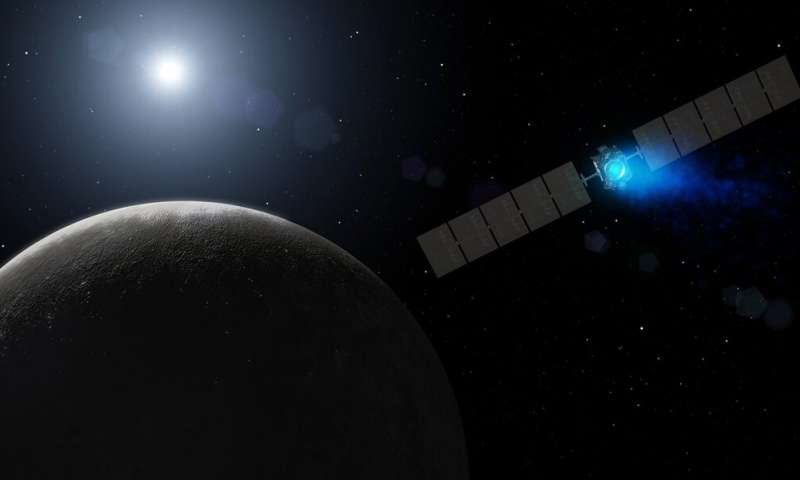
Aero/Astro engineer Ken Hara is developing computer models to help make a little-known, but widely-used thruster engine more suitable for long-distance missions.
When most people think of space travel, they imagine rockets like the towering Saturn V that sent the Apollo astronauts to the moon.
Most of that enormous rocket consisted of the fuel it burned to launch a tiny, crew-carrying space capsule into orbit. There, free of Earth's gravity, small bursts from fuel-burning thrusters guided the Apollo space capsule to the moon and back.
Since then, scientists have developed alternative thruster technologies that do not burn heavy fuels. Instead, these thrusters ionize stable gases like xenon and krypton, using electricity from solar cells to strip the electrons from the gas atoms to create a stream of positively charged ions, called a plasma. The spacecraft pushes this plasma out its exhaust to propel itself through the weightless void.
Such thrusters, known as electric propulsion engines, or plasma thrusters, currently enable hundreds of GPS, military and communications satellites make tiny course corrections and maintain stable orbits. But now, scientists are developing a new generation of ion thrusters capable of sending spacecraft on long-distance missions throughout the solar system, such as the Deep Space 1 module that visited asteroid 9969 Braille and comet Borrelly, and the Dawn spacecraft that traveled to the asteroid belt between Mars and Jupiter.
"Plasma thrusters represent the future of space exploration," said Ken Hara, an assistant professor of aeronautics and astronautics, who is helping develop computer models to make ion engines more powerful, efficient and useful.
Hara says the plasma thrusters have a number of advantages over their predecessors. For starters, the ionized gases used as the propellants in plasma thrusters weigh less than the fuels burned by the thrusters of the Apollo era. Every pound the spacecraft saves by lessening its fuel load means more weight to carry a larger scientific payload. Moreover, once a plasma-powered craft is in space, it can accelerate over time in a way that fuel-burning craft can't, ultimately giving these lightweight engines a speed advantage as well.
Understanding just why this is so involves a concept called exhaust velocity—the speed at which a propellant exits an engine. A traditional fuel-burning engine burns a huge volume of fuel but at a low exhaust velocity, a combination that produces tremendous thrust. Think about a rocket on the launch pad, moving slowly at first as it is lifted by a great billowing of flames, then accelerating as the tremendous thrust that is generated breaks the grip of gravity and hurls the rocket skyward.
By contrast, a plasma engine is designed for a different environment—propelling a spacecraft that is already in a low- or no-gravity environment. The plasma engine does this by emitting ionized particles at extremely high exhaust velocities, but very low volumes, propelling the spacecraft with what might be likened to puffs of breath. In the vacuum of space, with nothing to diminish the spacecraft's forward momentum, these puffs of ionized thrust allow the vessel to pick up speed over time, going both faster and further than fuel-burning spacecraft.
Hara, who was recently honored by the Electric Rocket Propulsion Society, is creating computer models to help improve plasma thrusters even further by exploring how plasmas can achieve faster and more powerful exhaust velocities. To do so, he needs to develop computational models that solve new equations and verify that they are correct under rigorous mathematical analysis. He then needs to validate these results by comparing his mathematical predictions with what experimental scientists demonstrate in real-world plasma thrusters. "Are we being mathematically sound, and are our models physically correct?" Hara asks rhetorically. "That's where my truth is."
Explore further
Citation: How better propulsion systems can improve space exploration (2020, February 21) retrieved 21 February 2020 from https://phys.org/news/2020-02-propulsion-space-exploration.html
This document is subject to copyright. Apart from any fair dealing for the purpose of private study or research, no part may be reproduced without the written permission. The content is provided for information purposes only.
https://news.google.com/__i/rss/rd/articles/CBMiP2h0dHBzOi8vcGh5cy5vcmcvbmV3cy8yMDIwLTAyLXByb3B1bHNpb24tc3BhY2UtZXhwbG9yYXRpb24uaHRtbNIBPmh0dHBzOi8vcGh5cy5vcmcvbmV3cy8yMDIwLTAyLXByb3B1bHNpb24tc3BhY2UtZXhwbG9yYXRpb24uYW1w?oc=5
2020-02-21 12:24:37Z
CAIiEKpUnuQG9fwFC-26JbDzTyEqGAgEKg8IACoHCAowpbDpAzCm_hww3-XGBg
Tidak ada komentar:
Posting Komentar